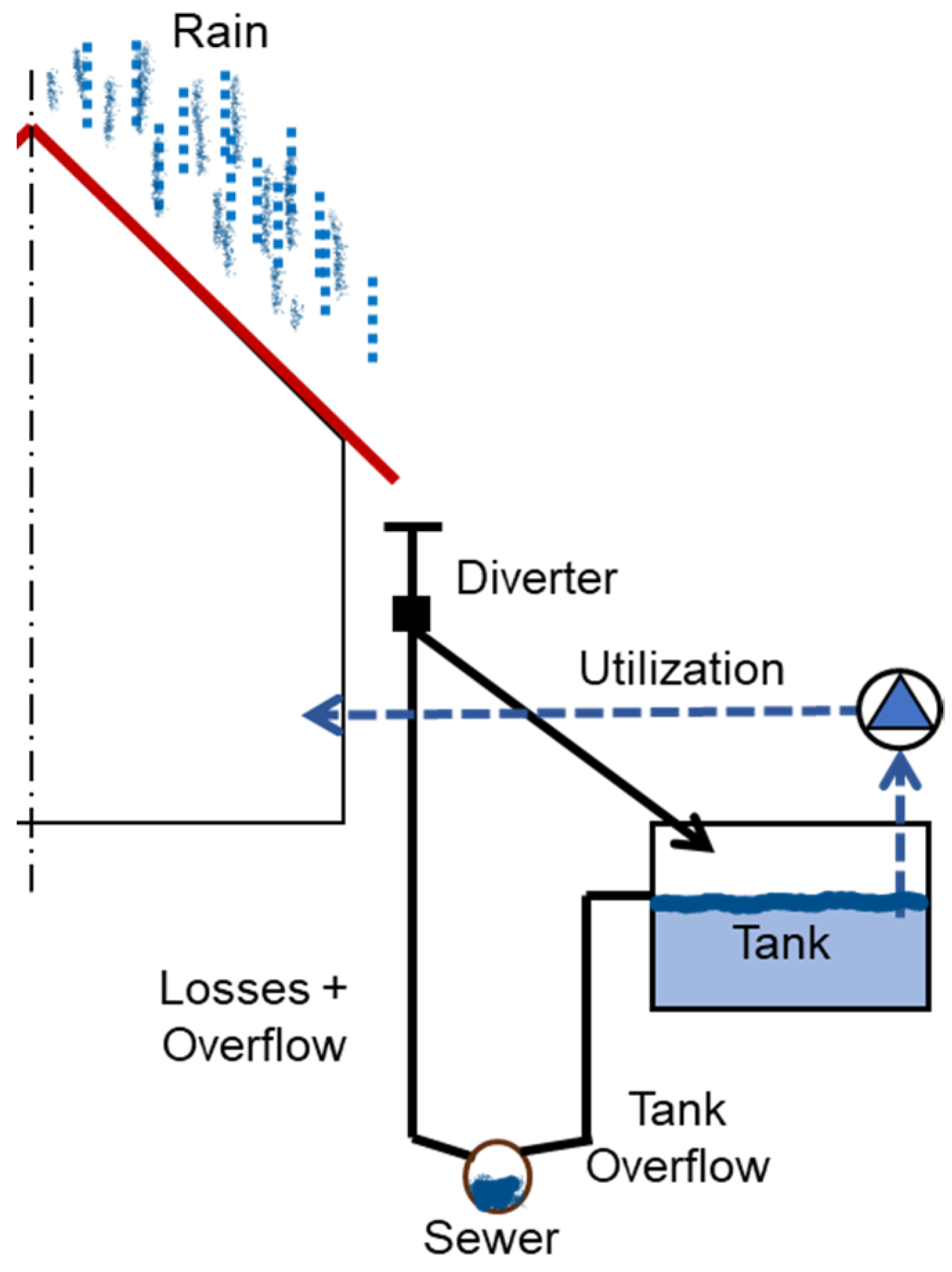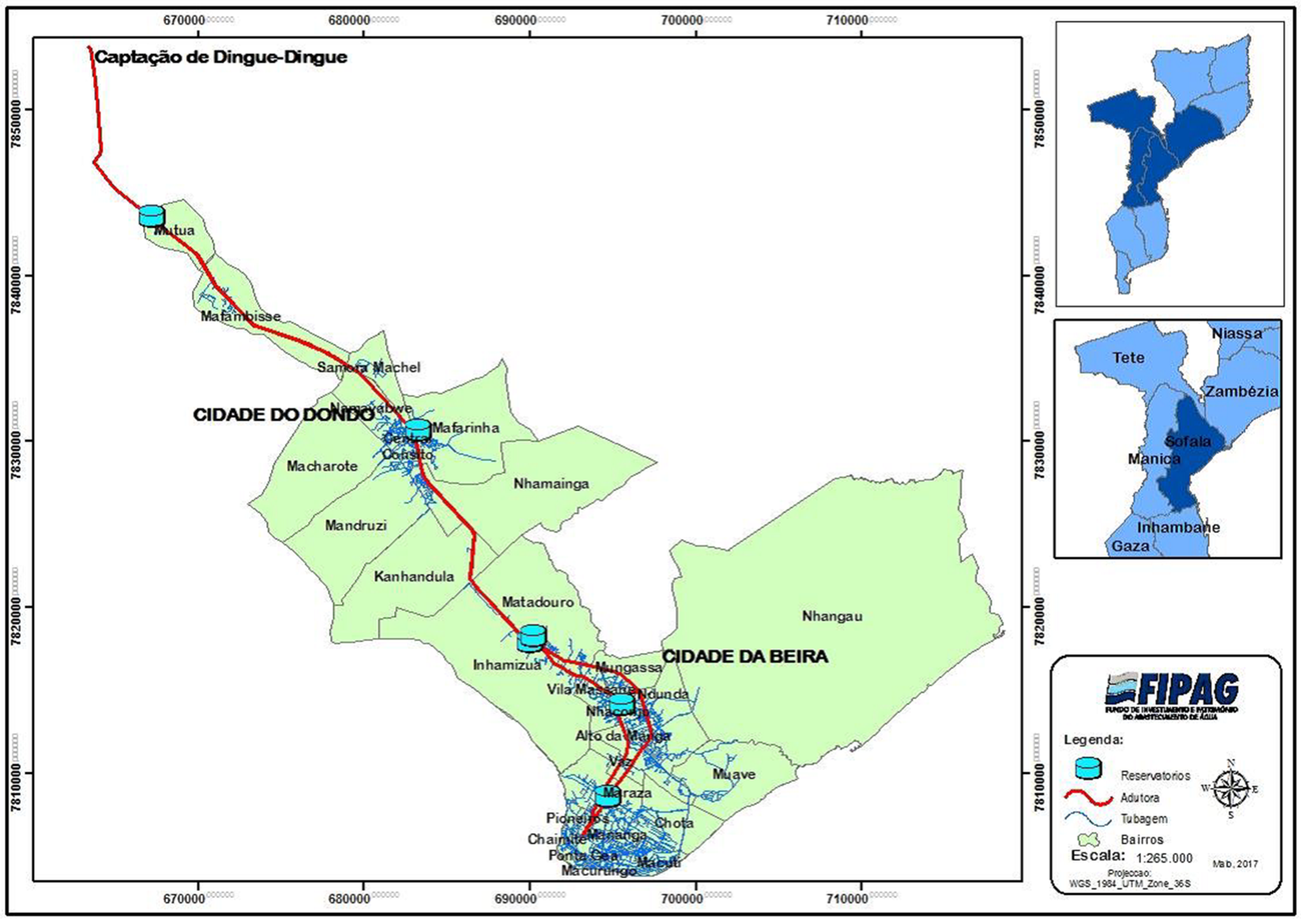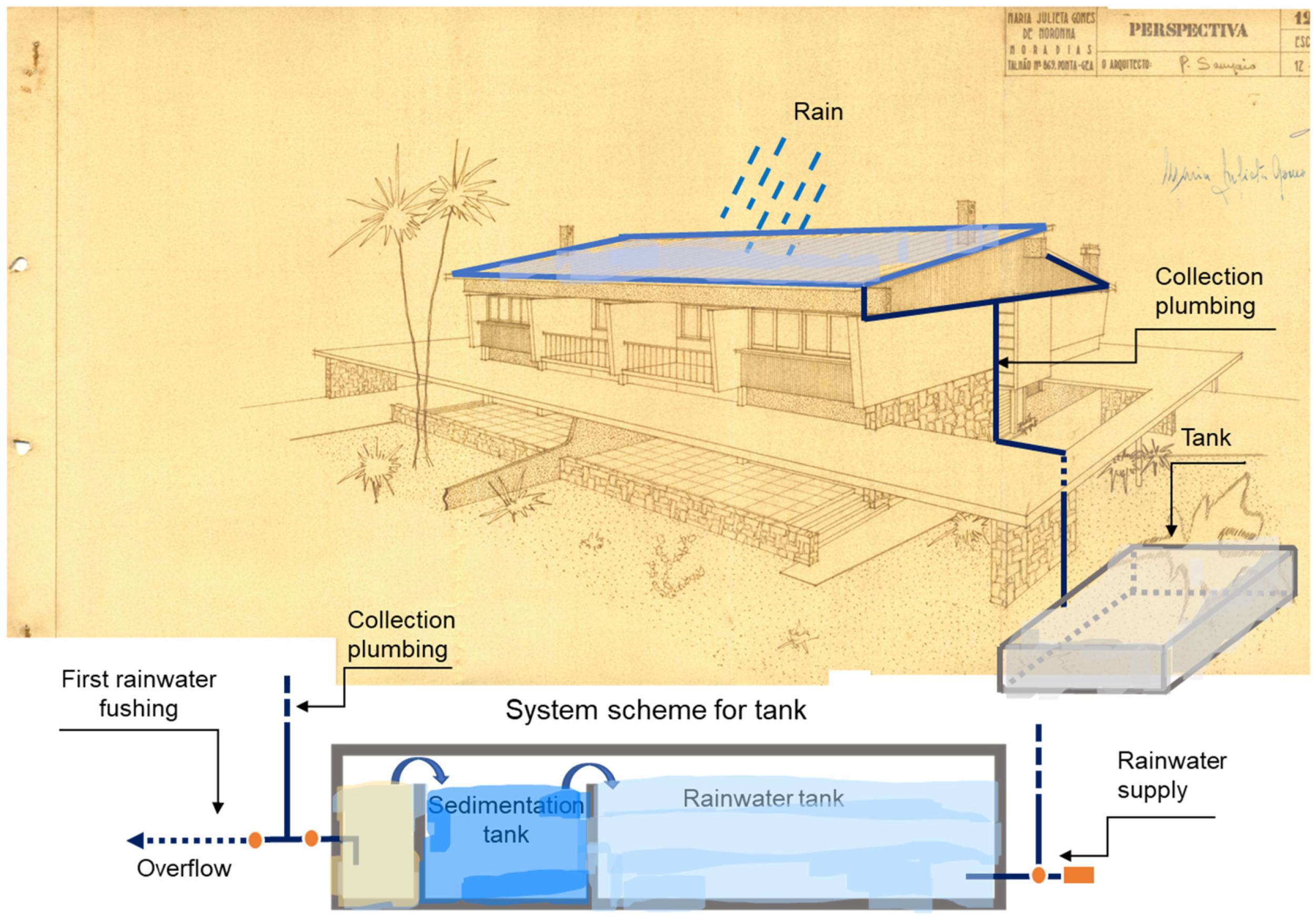The Possibilities of Capturing Rainwater and Reducing the Impact of Floods: A Proposal for the City of Beira, Mozambique
Abstract
1. Introduction

2. Materials and Methods
2.1. Case Study Building: Beira

2.2. Current Capture and Fueling System
2.3. Precipitation Data
2.4. Collected Water, Transport, Storage, and Distribution
3. Results
3.1. Precipitation
3.2. Rainwater Harvesting
4. Discussion
5. Conclusions
Supplementary Materials
Author Contributions
Funding
Informed Consent Statement
Data Availability Statement
Acknowledgments
Conflicts of Interest
Appendix A


References
- Ferreira, V.; Barreira, A.P.; Loures, L.; Antunes, D.; Panagopoulos, T. Stakeholders’ Engagement on Nature-Based Solutions: A Systematic Literature Review. Sustainability 2020, 12, 640. [Google Scholar] [CrossRef]
- Muller, M. Adapting to Climate Change: Water Management for Urban Resilience. Environ. Urban. 2007, 19, 99–113. [Google Scholar] [CrossRef]
- Faivre, N.; Fritz, M.; Freitas, T.; de Boissezon, B.; Vandewoestijne, S. Nature-Based Solutions in the EU: Innovating with Nature to Address Social, Economic and Environmental Challenges. Environ. Res. 2017, 159, 509–518. [Google Scholar] [CrossRef]
- Nguyen, T.T.; Ngo, H.H.; Guo, W.; Wang, X.C.; Ren, N.; Li, G.; Ding, J.; Liang, H. Implementation of a Specific Urban Water Management—Sponge City. Sci. Total Environ. 2019, 652, 147–162. [Google Scholar] [CrossRef] [PubMed]
- Ruidas, D.; Chakrabortty, R.; Islam, A.R.M.T.; Saha, A.; Pal, S.C. A Novel Hybrid of Meta-Optimization Approach for Flash Flood-Susceptibility Assessment in a Monsoon-Dominated Watershed, Eastern India. Environ. Earth Sci. 2022, 81, 145. [Google Scholar] [CrossRef]
- Hartnett, M.; Nash, S. High-Resolution Flood Modeling of Urban Areas Using MSN_Flood. Water Sci. Eng. 2017, 10, 175–183. [Google Scholar] [CrossRef]
- Roy, P.; Chandra Pal, S.; Chakrabortty, R.; Chowdhuri, I.; Malik, S.; Das, B. Threats of Climate and Land Use Change on Future Flood Susceptibility. J. Clean. Prod. 2020, 272, 122757. [Google Scholar] [CrossRef]
- Malik, S.; Chandra Pal, S.; Chowdhuri, I.; Chakrabortty, R.; Roy, P.; Das, B. Prediction of Highly Flood Prone Areas by GIS Based Heuristic and Statistical Model in a Monsoon Dominated Region of Bengal Basin. Remote Sens. Appl. 2020, 19, 100343. [Google Scholar] [CrossRef]
- Trenberth, K.E.; Shea, D.J. Relationships between Precipitation and Surface Temperature. Geophys. Res. Lett. 2005, 32, 1–4. [Google Scholar] [CrossRef]
- Zscheischler, J.; Seneviratne, S.I. Dependence of Drivers Affects Risks Associated with Compound Events. Sci. Adv. 2017, 3, e1700263. [Google Scholar] [CrossRef]
- Bevacqua, E.; Zappa, G.; Lehner, F.; Zscheischler, J. Precipitation Trends Determine Future Occurrences of Compound Hot–Dry Events. Nat. Clim. Change 2022, 12, 350–355. [Google Scholar] [CrossRef]
- Tschumi, E.; Zscheischler, J. Countrywide Climate Features during Recorded Climate-Related Disasters. Clim. Change 2020, 158, 593–609. [Google Scholar] [CrossRef] [PubMed]
- Ellah, R.G.A. Water Resources in Egypt and Their Challenges, Lake Nasser Case Study. Egypt. J. Aquat. Res. 2020, 46, 1–12. [Google Scholar] [CrossRef]
- Li, J.; Song, S.; Kang, Y.; Wang, H.; Wang, X. Prediction of Urban Domestic Water Consumption Considering Uncertainty. J. Water Resour. Plan. Manag. 2020, 147, 05020028. [Google Scholar] [CrossRef]
- UNESCO. The United Nations World Water Development Report 2021: Valuing Water; UNESCO: Paris, France, 2019. [Google Scholar]
- Alam, S.M. Ecologically Sustainable Development (ESD) Useful Australian Land Use Practice-Suitable for the World. Edelweiss Appl. Sci. Technol. 2019, 3, 36–43. [Google Scholar] [CrossRef]
- General Assembly United Nations. Transforming Our World: The 2030 Agenda for Sustainable Development, United Nations; Department of Economic and Social Affairs: New York, NY, USA, 2015. [Google Scholar]
- Inogwabini, B.I. Conserving and Restoring Water-Related Ecosystems World-Widely: Have We Met the 2020s the Benchmarks of the Sustainable Development Goal Six? In Sustainability in Natural Resources Management and Land Planning; Springer: Cham, Switzerland, 2021; pp. 3–16. [Google Scholar] [CrossRef]
- Progress on Level of Water Stress, Global Baseline for SDG Indicator 6.4.2; FAO/UN-Water: Rome, Italy, 2018; ISBN 978-92-5-130988-9.
- Wolka, K.; Biazin, B.; Martinsen, V.; Mulder, J. Soil and Water Conservation Management on Hill Slopes in Southwest Ethiopia. II. Modeling Effects of Soil Bunds on Surface Runoff and Maize Yield Using AquaCrop. J. Environ. Manag. 2021, 296, 113187. [Google Scholar] [CrossRef] [PubMed]
- Habtemariam, L.W.; Gelaye, F.A.; Du, J.; Mahendra, A. Water Resilience in a Changing Urban Context: Africa’s Challenge and Pathways for Action; World Resources Institute: Washington, DC, USA, 2021. [Google Scholar]
- The Challenge. Available online: https://files.wri.org/d8/s3fs-public/2021-05/africa-urban-water-resilience-initiative.pdf (accessed on 15 April 2022).
- GhaffarianHoseini, A.; Tookey, J.; GhaffarianHoseini, A.; Yusoff, S.M.; Hassan, N.B. State of the Art of Rainwater Harvesting Systems towards Promoting Green Built Environments: A Review. Desalination Water Treat. 2015, 57, 95–104. [Google Scholar] [CrossRef]
- Ferguson, B.C.; Brown, R.R.; Frantzeskaki, N.; de Haan, F.J.; Deletic, A. The Enabling Institutional Context for Integrated Water Management: Lessons from Melbourne. Water Res. 2013, 47, 7300–7314. [Google Scholar] [CrossRef]
- Chocat, B.; Ashley, R.; Marsalek, J.; Matos, M.R.; Rauch, W.; Schilling, W.; Urbonas, B. Toward the Sustainable Management of Urban Storm-Water. Indoor Built Environ. 2007, 16, 273–285. [Google Scholar] [CrossRef]
- Agudelo-Vera, C.M.; Leduc, W.R.W.A.; Mels, A.R.; Rijnaarts, H.H.M. Harvesting Urban Resources towards More Resilient Cities. Resour. Conserv. Recycl. 2012, 64, 3–12. [Google Scholar] [CrossRef]
- Zhang, Y.; Yang, Z.; Yu, X. Urban Metabolism: A Review of Current Knowledge and Directions for Future Study. Environ. Sci. Technol. 2015, 49, 11247–11263. [Google Scholar] [CrossRef] [PubMed]
- United Nations, Department of Economic and Social Affairs. Population Division. Probabilistic Population Projections Rev. 1 Based on the World Population Prospects 2019 Rev. 1. 2019. Available online: https://population.un.org/wpp/ (accessed on 7 May 2022).
- Rijke, J.; Farrelly, M.; Brown, R.; Zevenbergen, C. Configuring Transformative Governance to Enhance Resilient Urban Water Systems. Environ. Sci. Policy 2013, 25, 62–72. [Google Scholar] [CrossRef]
- Bayulken, B.; Huisingh, D.; Fisher, P.M.J. How Are Nature Based Solutions Helping in the Greening of Cities in the Context of Crises Such as Climate Change and Pandemics? A Comprehensive Review. J. Clean. Prod. 2021, 288, 125569. [Google Scholar] [CrossRef]
- Eggermont, H.; Balian, E.; Azevedo, J.M.N.; Beumer, V.; Brodin, T.; Claudet, J.; Fady, B.; Grube, M.; Keune, H.; Lamarque, P.; et al. Nature-Based Solutions: New Influence for Environmental Management and Research in Europe. GAIA 2015, 24, 243–248. [Google Scholar] [CrossRef]
- Bell, J.; Paula, L.; Dodd, T.; Németh, S.; Nanou, C.; Mega, V.; Campos, P. EU Ambition to Build the World’s Leading Bioeconomy—Uncertain Times Demand Innovative and Sustainable Solutions. New Biotechnol. 2018, 40, 25–30. [Google Scholar] [CrossRef]
- Keath, N.A.; Brown, R.R. Extreme Events: Being Prepared for the Pitfalls with Progressing Sustainable Urban Water Management. Water Sci. Technol. 2009, 59, 1271–1280. [Google Scholar] [CrossRef]
- Lundy, L.; Wade, R. Integrating Sciences to Sustain Urban Ecosystem Services. Prog. Phys. Geogr. Earth Environ. 2011, 35, 653–669. [Google Scholar] [CrossRef]
- Herrmann, T.; Schmida, U. Rainwater Utilisation in Germany: Efficiency, Dimensioning, Hydraulic and Environmental Aspects. Urban Water 2000, 1, 307–316. [Google Scholar] [CrossRef]
- Lafforgue, M.; Lenouvel, V. Closing the Urban Water Loop: Lessons from Singapore and Windhoek. Environ. Sci. 2015, 1, 622–631. [Google Scholar] [CrossRef]
- Wang, C.H.; Blackmore, J.M. Supply-Demand Risk and Resilience Assessment for Household Rainwater Harvesting in Melbourne, Australia. Water Resour. Manag. 2012, 26, 4381–4396. [Google Scholar] [CrossRef]
- Coombes, P.J.; Barry, M.E. The Relative Efficiency of Water Supply Catchments and Rainwater Tanks in Cities Subject to Variable Climate and the Potential for Climate Change. Australas. J. Water Resour. 2015, 12, 85–100. [Google Scholar] [CrossRef]
- Carvalho, J.W. de Configuração Urbana e Balanço Hídrico Com Aplicação Do Modelo Aquacycle Na Bacia Hidrográ-Fica Do Rio Belém-Curitiba/PR; Universidade Fereral do Paraná: Curitiba, Brazil, 2016. [Google Scholar]
- Teston, A.; Geraldi, M.S.; Colasio, B.M.; Ghisi, E. Rainwater Harvesting in Buildings in Brazil: A Literature Review. Water 2018, 10, 471. [Google Scholar] [CrossRef]
- Shafique, M.; Kim, R. Recent Progress in Low-Impact Development in South Korea: Water-Management Policies, Challenges and Opportunities. Water 2018, 10, 435. [Google Scholar] [CrossRef]
- Warren, M. Why Cyclone Idai Is One of the Southern Hemisphere’s Most Devastating Storms. Nature 2019. [Google Scholar] [CrossRef] [PubMed]
- Zhang, S.; Zhang, J.; Yue, T.; Jing, X. Impacts of Climate Change on Urban Rainwater Harvesting Systems. Sci. Total Environ. 2019, 665, 262–274. [Google Scholar] [CrossRef]
- Santos, M.M.; Ferreira, A.V.; Lanzinha, J.C.G. Colonial Moorings on Spatial Planning of Mozambique. Cities 2022, 124, 103619. [Google Scholar] [CrossRef]
- Santos, M.M.; Ferreira, A.V.; Lanzinha, J.C.G. Building and Urban Characteristics for the Development of Intervention Strategies in the Ponte Gêa Neighborhood of Beira. In Proceedings of the 9th Euro-American Congress on Construction Pathology, Rehabilitation Technology and Heritage Management—REHABEND2022, Granada, Spain, 13–16 September 2022; pp. 395–404. [Google Scholar]
- Mozambique: Beira City—Neighbourhood Damage Assessment—As of 26 March 2019—Mozambique | ReliefWeb. Available online: https://reliefweb.int/map/mozambique/mozambique-beira-city-neighbourhood-damage-assessment-26-march-2019 (accessed on 18 December 2022).
- Silva, C.M.; Sousa, V.; Carvalho, N.V. Evaluation of Rainwater Harvesting in Portugal: Application to Single-Family Residences. Resour. Conserv. Recycl. 2015, 94, 21–34. [Google Scholar] [CrossRef]
- Meteonorm Version 8—Meteonorm (En). Available online: https://meteonorm.com/en/meteonorm-version-8 (accessed on 7 May 2022).
- Comissão Técnica 0701. Available online: https://anqip.pt/index.php/pt/comissoes-tecnicas/93-comissao-tecnica-0701 (accessed on 17 April 2022).
- Jing, X.; Zhang, S.; Zhang, J.; Wang, Y.; Wang, Y. Assessing Efficiency and Economic Viability of Rainwater Harvesting Systems for Meeting Non-Potable Water Demands in Four Climatic Zones of China. Resour. Conserv. Recycl. 2017, 126, 74–85. [Google Scholar] [CrossRef]
- Pavolová, H.; Bakalár, T.; Kudelas, D.; Puškárová, P. Environmental and Economic Assessment of Rainwater Application in Households. J. Clean. Prod. 2019, 209, 1119–1125. [Google Scholar] [CrossRef]
- Giudicianni, C.; Herrera, M.; di Nardo, A.; Carravetta, A.; Ramos, H.M.; Adeyeye, K. Zero-Net Energy Management for the Monitoring and Control of Dynamically-Partitioned Smart Water Systems. J. Clean. Prod. 2020, 252, 119745. [Google Scholar] [CrossRef]
- Santos, M.M.; Lanzinha, J.C.G.; Ferreira, A.V. Proposal for a Methodology for Sustainable Rehabilitation Strategies of the Existing Building Stock—The Ponte Gêa Neighborhood. Designs 2021, 5, 26. [Google Scholar] [CrossRef]
- Crosson, C.; Tong, D.; Zhang, Y.; Zhong, Q. Rainwater as a Renewable Resource to Achieve Net Zero Urban Water in Water Stressed Cities. Resour. Conserv. Recycl. 2021, 164, 105203. [Google Scholar] [CrossRef]
- Instituto de Água de Portugal. Projecto de Regulamento Dos Sistemas Públicos de Distribuição de Água e de Drenagem de Águas Residuais de Moçambique; LNEC: Lisboa, Portugal, 2000. [Google Scholar]
- Andrade, L.R.; Maia, A.G.; Lucio, P.S. Relevance of Hydrological Variables in Water-Saving Efficiency of Domestic Rainwater Tanks: Multivariate Statistical Analysis. J. Hydrol. 2017, 545, 163–171. [Google Scholar] [CrossRef]
- Eng, S.A.H.P. Harvesting Rainwater from Buildings; Springer: Berlin/Heidelberg, Germany, 2017; pp. 1–266. [Google Scholar] [CrossRef]
- Durham, B.; Mierzejewski, M. Water Reuse and Zero Liquid Discharge: A Sustainable Water Resource Solution. Water Sci. Technol. Water Supply 2003, 3, 97–103. [Google Scholar] [CrossRef]
- Huisman, L.; Wood, W. Slow Sand Filtration; World Health Organization, Ed.; World Health Organization: Geneva, Switzerland, 1974; ISBN 92.4.154037.0. [Google Scholar]
- da Costa, P.C.L.; de Azevedo, A.R.G.; da Silva, F.C.; Cecchin, D.; do Carmo, D.D.F. Rainwater Treatment Using an Acrylic Blanket as a Filtering Media. J. Clean. Prod. 2021, 303, 126964. [Google Scholar] [CrossRef]
- Gleick, P.H.; Macdonald, G.M. Roadmap for Sustainable Water Resources in Southwestern North America. Proc. Natl. Acad. Sci. USA 2010, 107, 21300–21305. [Google Scholar] [CrossRef]
- Askarizadeh, A.; Rippy, M.A.; Fletcher, T.D.; Feldman, D.L.; Peng, J.; Bowler, P.; Mehring, A.S.; Winfrey, B.K.; Vrugt, J.A.; Aghakouchak, A.; et al. From Rain Tanks to Catchments: Use of Low-Impact Development To Address Hydrologic Symptoms of the Urban Stream Syndrome. Environ. Sci. Technol. 2015, 49, 11264–11280. [Google Scholar] [CrossRef] [PubMed]
- Hatt, B.E.; Deletic, A.; Fletcher, T.D. Integrated Treatment and Recycling of Stormwater: A Review of Australian Practice. J. Environ. Manag. 2006, 79, 102–113. [Google Scholar] [CrossRef]
- Palla, A.; Gnecco, I.; la Barbera, P. The Impact of Domestic Rainwater Harvesting Systems in Storm Water Runoff Mitigation at the Urban Block Scale. J. Environ. Manag. 2017, 191, 297–305. [Google Scholar] [CrossRef]
- Orta-Ortiz, M.S.; Geneletti, D. Reviewing the Performance of Nature-Based Solutions for Stormwater Management in Urban Areas. Lect. Notes Civ. Eng. 2021, 146, 15–22. [Google Scholar] [CrossRef]
- Higher, E.; Deshmukh, A.; Überbacher, A.; Sanna, A.; Câmara, G.; Sundermann, K.; Zhang, M.; Nagels, M.; Koshy, M.; Gupta, R.; et al. The Pattern Book European Postgrate Master in Urbanism Strategies and Design for Cities and Territories; Delt University of Technology: Delt, The Netherlads, 2013. [Google Scholar]







| Title 1 | Jan | Feb | Mar | Apr | May | Jun | Jul | Aug | Sep | Oct | Nov | Dec |
|---|---|---|---|---|---|---|---|---|---|---|---|---|
| C | 0.8 | 0.8 | 0.8 | 0.8 | 0.8 | 0.8 | 0.8 | 0.8 | 0.8 | 0.8 | 0.8 | 0.8 |
| P (mm) | 282.1 | 267.2 | 252.1 | 135.3 | 41.3 | 35.9 | 68.2 | 23.3 | 14.4 | 46.2 | 103.0 | 224.4 |
| A (m2) | 210 | 210 | 210 | 210 | 210 | 210 | 210 | 210 | 210 | 210 | 210 | 210 |
| ηf | 0.9 | 0.9 | 0.9 | 0.9 | 0.9 | 0.9 | 0.9 | 0.9 | 0.9 | 0.9 | 0.9 | 0.9 |
| Va (liters) | 42,657 | 40,405 | 38,112 | 20,464 | 6248 | 5432 | 10,308 | 3522 | 2180 | 6989 | 15,580 | 33,931 |
| Vd (liters) | 1050 | 1050 | 1050 | 1050 | 1050 | 1050 | 1050 | 1050 | 1050 | 1050 | 1050 | 1050 |
| Varec (liters) | 41,607 | 39,355 | 37,062 | 19,414 | 5198 | 4382 | 9258 | 2472 | 1130 | 5939 | 14,530 | 32,881 |
Disclaimer/Publisher’s Note: The statements, opinions and data contained in all publications are solely those of the individual author(s) and contributor(s) and not of MDPI and/or the editor(s). MDPI and/or the editor(s) disclaim responsibility for any injury to people or property resulting from any ideas, methods, instructions or products referred to in the content. |
© 2023 by the authors. Licensee MDPI, Basel, Switzerland. This article is an open access article distributed under the terms and conditions of the Creative Commons Attribution (CC BY) license (https://creativecommons.org/licenses/by/4.0/).
Share and Cite
Santos, M.M.; Ferreira, A.V.; Lanzinha, J.C.G. The Possibilities of Capturing Rainwater and Reducing the Impact of Floods: A Proposal for the City of Beira, Mozambique. Sustainability 2023, 15, 2276. https://doi.org/10.3390/su15032276
Santos MM, Ferreira AV, Lanzinha JCG. The Possibilities of Capturing Rainwater and Reducing the Impact of Floods: A Proposal for the City of Beira, Mozambique. Sustainability. 2023; 15(3):2276. https://doi.org/10.3390/su15032276
Chicago/Turabian StyleSantos, Michael M., Ana Vaz Ferreira, and João C. G. Lanzinha. 2023. "The Possibilities of Capturing Rainwater and Reducing the Impact of Floods: A Proposal for the City of Beira, Mozambique" Sustainability 15, no. 3: 2276. https://doi.org/10.3390/su15032276
APA StyleSantos, M. M., Ferreira, A. V., & Lanzinha, J. C. G. (2023). The Possibilities of Capturing Rainwater and Reducing the Impact of Floods: A Proposal for the City of Beira, Mozambique. Sustainability, 15(3), 2276. https://doi.org/10.3390/su15032276









